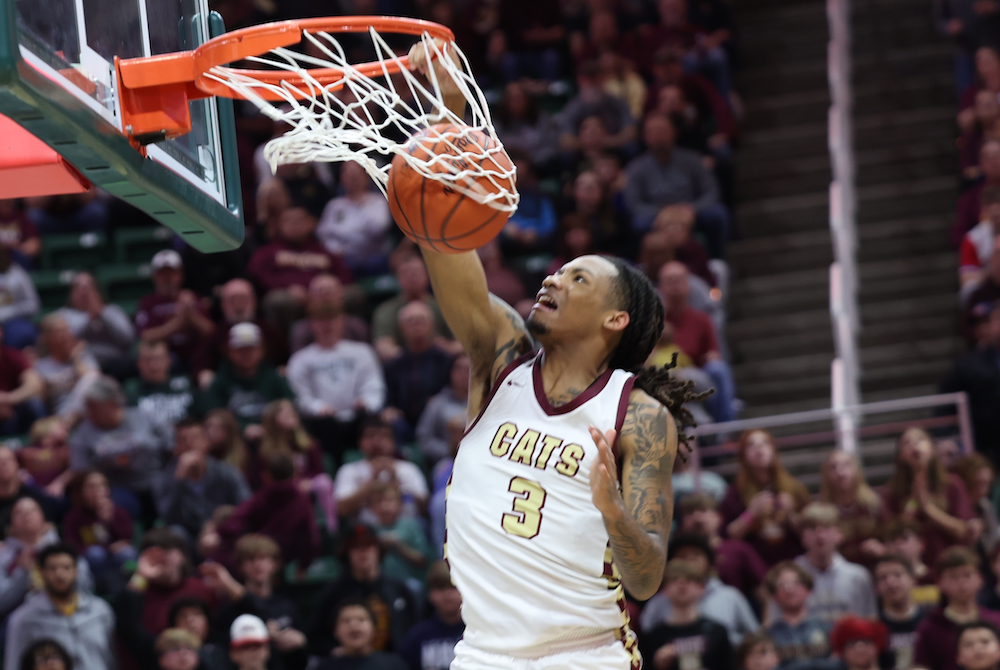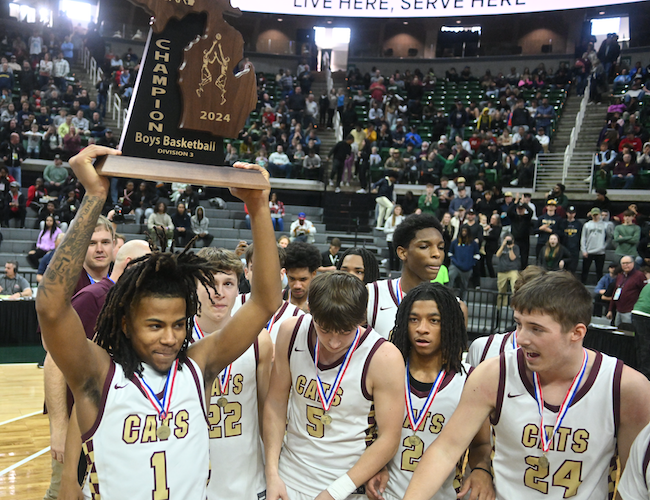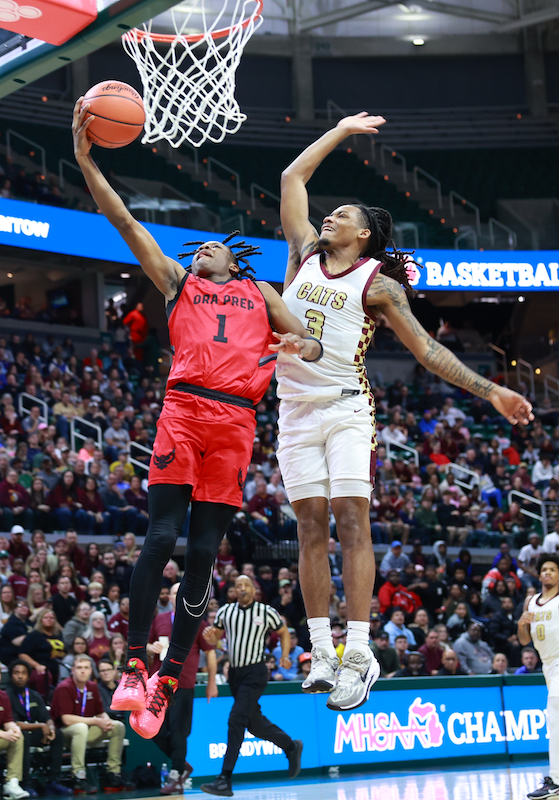
MHSA(Q&)A: Historian Ron Pesch
April 16, 2012
 When we receive a question on the history of MHSAA athletics that we can't answer on the spot, Muskegon's Ron Pesch is the first person we seek out for help.
When we receive a question on the history of MHSAA athletics that we can't answer on the spot, Muskegon's Ron Pesch is the first person we seek out for help.
Pesch took the reins as Michigan's chief high school sports historian during the mid 1990s after the retirement of legendary MHSAA record book originator Dick Kishpaugh and has contributed to various efforts and publications across the state.
One of his latest projects is the awarding of "retro" Mr. Basketball Awards. The first Hal Schram Mr. Basketball Award was given by the Basketball Coaches Association of Michigan in 1981 to Lansing Eastern's Sam Vincent. Three seasons ago, BCAM -- with research work by Pesch -- began awarding retro winners for the previous decades beginning with the 1920s. This winter, BCAM honored retro winners from 1922, 1932, 1942, 1952, 1962 and 1972.
Click to read more about those winners and the finalists recognized last month. Also, click for links to the previous retro winners. The retro Mr. Basketball project will last seven more seasons. Pesch explains more below.
How did you come up with rewarding a “Retro” Mr. Basketball?
The project came out of a conversation I had with (BCAM executive director) Tom Hursey at the basketball finals back in '99. Together, we hatched an approach honoring the state's past basketball greats. He let me run with it, while he worked on getting a subcommittee launched to make the selection.
How do you dig up all of this nomination info?
Between votes, I work on digging out the details. My initial target list always begins with all-state teams - if, of course they exist. All-tournament teams for the early years also serve as a starting point -- if they exist. Best I can tell, the Detroit Times, the Free Press and the News have all named all-state squads, at various points, back to about 1935. The Associated Press and UPI came to the game much later - somewhere around the early to mid 1960s. I then work on creating a crosstab on the players selected, noting the "teams" on which they were named (Class A 1st team, Dream Team, Class C 3rd team), and try to find quotes detailing their games. The result is really a reflection of the times and the history of newspaper reporting.
In early years, we can struggle to uncover a player’s first name, let alone his class in school. And statistical coverage of a player's abilities was very limited. It's simply the way things were back then. Everyone in town knew King Lewis, or Red Cherry, or Young Jacks. And the final box score only contained points, fouls, substitutions, as they were all you really needed to know about the game. But by visiting the state library in Lansing, and looking at a cross-section of newspapers, you can usually dig out what you need.
Do you collect from other sources as well?
Another source is high school yearbooks. Some resources have started to emerge online. I also tap into the MHSAA site and make contact with ADs around the state, asking for their assistance on digging out details - especially class in school. Like the current program, only "seniors" are considered for the award. Mid-year graduates can create a challenge, but the rule currently in place is a player is considered a nominee in the year in which he was last eligible for the state tournament. In other words, if you graduated in January or February of 1943, you would be considered for the 1942 ballot. It appears that a similar approach was used in selecting all-state teams.
|
Year |
Player |
High School |
Age |
Height |
Weight |
Year |
DFP |
DN |
DT |
AP |
UPI |
Tourney |
|
1971 A-1 G. |
Frank Tanana, Jr. (C) |
Detroit Catholic Central |
17 |
6-3 |
170 |
Sr. |
A1 |
A1 |
A1 |
A1 |
||
|
1971 A-1 C |
Tom McGill |
Flint Northern |
17 |
6-3 |
190 |
Sr. |
A1 |
DM |
A1 |
A1 |
||
|
1971 A-1 F. |
Lindsay Hairston |
Detroit Kettering |
17 |
6-9 |
203 |
Sr. |
A1 |
DM |
A1 |
A1 |
||
|
1971 A-1 F. |
Campy Russell |
Pontiac Central |
18 |
6-7 |
190 |
Sr. |
A1 |
DM |
A1 |
A1 |
That cross-tab table will help establish a list of nominees. A consensus first-team pick is an obvious candidate. When only a single all-state team is available, I'll do what I can to look up all-conference teams or all-area teams from around the state to see who else might be considered. While life after high school is not a considered when trying to pick a winner, a player who emerges as a star in college or in the pros may emerge as a candidate when you see his details in a local paper.
Bios are assembled from the newspaper reports, detailing as much as we can find on high school player's career. I'll tap into a variety of resources including old team histories when available. When needed, I'll toss out request to reporters, old and new, around the state. Local librarians and historians are another wonderful resource.
How does voting work?
Between sessions of the Boys Finals, the committee assembles to hash out a final ballot, and to make a selection. I don't vote, but I may guide the conversation and provide any additional details when needed, reminding members that we're focusing on their high school careers. The process is certainly imperfect. But the committee approach prevents the process from becoming a popularity contest. These guys have the benefit of watching many of the players play. And, like the current Mr. Basketball program, they sometimes surprise. But that's what makes it fun. And, of course, stirs the pot. It gets people talking about the history of basketball in this state.
Is there a theme to MHSAA basketball that has remained constant over the years?
For me the greatest thing about the basketball tournament is that it assembles a wide range of folks who want to see players they've heard about in action. And the process, for the most part, hasn't change since the 1920s. While the style of the game has changed, winning a title is much the same as it was back when our great-grandfathers played: You gotta get through the tournament. And only four trophies are awarded.
These guys were the "Magic" of their day. I'm hoping we never forget that.

Brandywine Seizes Momentum on Dunk, Rides Surge to 1st Championship Win
By
Steve Vedder
Special for MHSAA.com
March 16, 2024
EAST LANSING – It may be a stretch to believe a lone play early in a third quarter could decide a state championship game, but that's the best explanation Niles Brandywine could offer.
A steal and ensuing slam dunk ignited eight dominating minutes that earned the Bobcats their first MHSAA Finals title with Saturday's 56-48 win over Detroit Old Redford in Division 3 at the Breslin Center.
A steal and subsequent dunk by senior guard Jaremiah Palmer during the third period's opening seconds were what players credited with turning around a contest which saw Brandywine actually outscore Old Redford in just that one quarter.
"Jaremiah got the steal and the dunk, and we just kept it going after that," senior guard Byron Linley said. "We saw his intensity, and we wanted to match it."
 Prior to Palmer's steal and basket, Niles Brandywine had led only 4-1 midway through the first quarter and for less than three minutes of the second quarter, entering halftime down 24-23.
Prior to Palmer's steal and basket, Niles Brandywine had led only 4-1 midway through the first quarter and for less than three minutes of the second quarter, entering halftime down 24-23.
But Palmer's exploits kicked off a 20-5 third-quarter surge which led the Bobcats to as much as a 44-31 lead halfway through the period.
"Our goal was to come here and win and finish (the season) in a good way, and we did," Jaremiah Palmer said.
Senior guard Jamier Palmer said it wasn't the first time the Bobcats have rallied in the second half, and the steal and dunk were at least a key part of the championship win.
"I think so," he said. "We've been down before and fought our way back. Against Benton Harbor we were down like 20 points, and we still made that game ours."
Senior center Brock Dye said at halftime players talked about making a big play.
"We knew we had to change things, that we couldn't be one stop short," he said. "Then we got the dunk, and everything changed quickly. It energized us. We told ourselves, 'OK, we're here to play.'"
Brandywine coach Nate Knapp, whose team has won 51 games over the last two seasons, said while the steal and dunk played a part, he also credited defense. The team gave up an average of just 39 points over seven tournament wins. Old Redford (21-8) shot just 38 percent from the floor while missing 16 of 18 3-point attempts.
"We have five guys on the floor and one heartbeat," Knapp said. "We take things one step at a time. That's what we preach, and that's what the kids buy into."
 Jaremiah Palmer finished with18 points, six rebounds and three steals while Ja'Torian Smith had seven points and 10 rebounds.
Jaremiah Palmer finished with18 points, six rebounds and three steals while Ja'Torian Smith had seven points and 10 rebounds.
Sophomore Jaylin Muldrow had 14 points and Ja'Quan Stennis added 10 for Old Redford. The Ravens started only one senior in forward Justin Adams, while underclassmen scored all 48 points.
Old Redford coach Ray Reeves said the team settled for jump shots instead of getting the ball inside, and also set far too many picks on offense. Brandywine held a 36-27 advantage on the boards, with 13 offensive rebounds.
"They were more aggressive than us, and I think experience came into play," he said. "We've been outrebounding teams, and tonight they killed us. There are no excuses, we just didn't rebound or get to the line. They dominated both.
"From the middle of the first quarter on, they attacked the boards and got the ball down the floor. They did the things that got us here."
Knapp said defense has been a strength all season.
"Defense wins big games; you've got to defend," he said. "We said tonight we've got to do one of our best jobs of stopping their penetration and help box out. We came out and imposed our will in the third quarter.”
PHOTOS (Top) Jaremiah Palmer slam dunks during Niles Brandywine’s Division 3 championship win Saturday at Breslin Center. (Middle) Jamier Palmer (1) raises the trophy surrounded by teammates. (Below) Old Redford’s Jaylin Muldrow (1) gets to the basket with Jaremiah Palmer defending. (Photos by Hockey Weekly Action Photos.)

